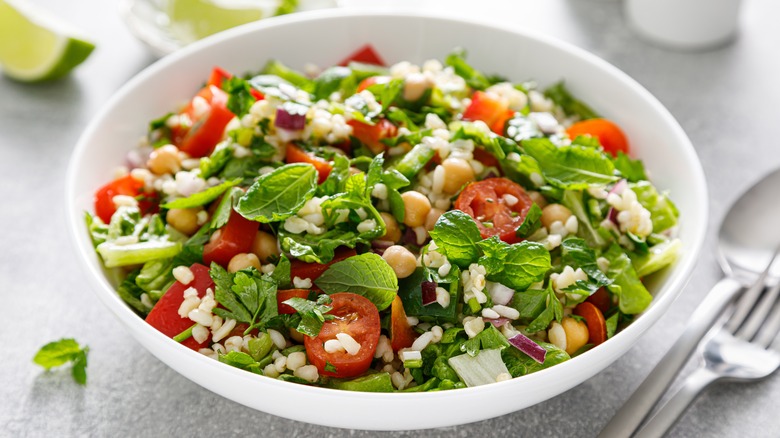Ina Garten's Dressing Advice For Better Grain Salads
We may receive a commission on purchases made from links.
Grain salads are the heroes of meal prep any time of year. A giant batch can be made at the beginning of the week and enjoyed as a delicious lunch, dinner, or side dish for days. Grain salads can be hearty vegetarian main courses served at any temperature.
Made with quinoa, farro, spelt, rye berries, wild rice, barley, or millet, grain salads are versatile and more forgiving than a green salad, which will wilt or get mushy over time. Whole grain salads maintain their structure for days and can be filled with a rainbow of raw or roasted veggies, fruit, nuts, and cheese.
While any vinaigrette will do, Ina Garten has good advice for when to dress a grain salad. Unlike a salad made with tender lettuce, grain salads should be dressed early on. In the Barefoot Contessa's cookbook, "Cook Like A Pro," Garten recommends adding the dressing while the grains are still warm to get a more flavorful salad. Similar to how pasta should cook for the last two minutes in its sauce, warm grains absorb the dressing tanks to their hygroscopic nature, flavoring the dish from the inside. If the dressing is added to cold grains, it'll still taste good, but it will just coat the dish.
One of the most appealing things about a grain salad, besides how economical it is, is that you don't need a recipe. They can be made with any ingredient available and are a great way to use leftovers.
How to build a better grain salad
Whole grains like quinoa are nutrient-dense, including fiber and protein, making them an excellent option for vegetarian meals like our grilled corn and quinoa salad. Although you can cook them similarly, unlike pasta salads, whole grains won't get hard when refrigerated, so they're just as good the next day. Boil them in salted water or stock until al dente and strain them for a foolproof cooking method.
Grain salads can be filled with in-season fresh vegetables, pantry staples, or studded with roasted veggies in the winter to bring out their sweetness. When prepping the ingredients, mimic grain size — slice the veggies like a chopped salad, so each bite contains a little bit of everything.
In the warmer months, when local produce is abundant, dice cherry tomatoes, summer squash, and raw corn from the cob for a superfood grain salad. When veggies aren't at their peak, add roasted beets, butternut squash, or sweet potatoes. For additional fiber, include chickpeas — rinsed from a can — seeds, or nuts.
When dressing the salad, pick a vinaigrette style rather than a creamy dressing like ranch, which won't absorb into the grains. Start with equal parts acid (citrus or vinegar) and oil, and season the dressing with salt, pepper, and fresh herbs. You'll need ½ cup of dressing for every two cups of salad. And, as Ina Garten suggests, add it to the salad when it's warm, so each grain soaks up some of the flavor.
The key is in the details
Although a recipe isn't necessary, there are a few things to remember so your grain salad tastes great all week. Delicious grain salads offer contrasting textures, colors, and flavors. Along with the nutty whole grains, add crunch with raw veggies or nuts and a creamy element like cheese. For sweetness, consider dried cherries, fresh corn when in season, or caramelized veggies like onions, eggplant, or squash. Finish the dish with acidity, either in the dressing or using pickled veggies, and you have the blueprint for the perfect meal.
If you plan on eating the dish for multiple days, choose vegetables that won't get soggy or brown quickly. Think peppers, carrots, cherry tomatoes, fennel, celery, and jicama. Larger tomatoes and cucumbers should be seeded first to keep the dish from getting watery. To remove excess water from greens like kale, escarole, and Swiss chard, sauté or steam them first. Baby spinach is the exception and can be added raw or mixed into the hot grains to wilt a little. Green vegetables like broccoli, green beans, and asparagus can be added raw or blanched to take the bite out. If you'd like to include avocado, add it right before serving, so it doesn't oxidize. This tip applies to most fresh fruit, such as apples, orange segments, and even pomegranate seeds.



